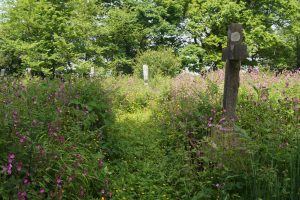Bring your churchyard to life
With summer in full swing, hedgerows and churchyards across the South West are providing havens for wildflowers and wildlife. 
The Living Churchyards programme aims to make churchyards a sanctuary for a huge range of species from flowers and plants to butterflies and moths, birds and bees as well as pleasant, reflective places for the congregation and visitors. Churchyards are also very important for lichens because of the wide range of stone types present in the form of gravestones.
Launched in 1993, there are now thousands of churchyards across the country run as sacred eco-systems, without pesticides and carefully timed cutting, to ensure birds, reptiles, bats and insects can thrive. One of those is at St Gwinear Church in south Cornwall.
St Gwinear has four churchyards and in 2010 volunteers from the Conservation Volunteers helped the church turn their Victorian cemetery into a Living Churchyard.
The Victorian cemetery, which has 100 graves, had become overgrown with bracken and brambles and it took volunteers two weeks to clear it to allow other native species to take over. Now the space boasts a huge variety including some rare plants.
Nicolas Herian, who is a member of Gwinear PCC and sits on the Bishop’s Diocesan Council, said: “This wildlife garden is now a rich resource for bats, butterflies, ground nesting birds and even the colony of bees in our church tower. We are finding new plants and if you come and walk around you’ll find them marked by sticks. The area is also a valuable space for our community. It’s a place of interest and we have seats for people to sit if they need some quiet reflection.”
The cemetery has roughly mown paths to allow visitors to be able to get around the site but Nicolas says the area isn’t just left. “The garden has to be properly managed or else brambles and bracken would just take over. Maintenance work is carefully planned by our gardener to fit in with the wildlife. We have also put in a compost area to ensure we recycle what we do cut.”
The church has two graveyards still in active use and these are kept as neatly cut lawn to enable relatives to tend the graves with ease. The other graveyard around the church is also playing its part with a wide range of lichen on display on the various headstones.
Could your churchyard be a Living Churchyard?
Churchyards wishing to become a Living Churchyard are simply asked to consider adopting the following four principles:
1. Involve the community
Involving the local community through a school, parish council or local group can benefit a churchyard project greatly and help to qualify for funding. Involvement can range from getting people out for a day’s practical work, to having a wildlife trail for children in the churchyard. People are more likely to be interested in the management and future of the churchyard if they feel involved in looking after it.2. Adopt a Wildlife Policy
Adopt an ecological management policy. This would be something listing key principles the churchyard would follow for wildlife management. For example, statements on grass cutting regimes, interpretation and pesticide use. This does not have to be a detailed management plan, it can be a simple record in the form of an annotated map, with areas for management marked on it.3. Gather records
Keeping simple records is useful for future reference and comparison. Records of wildlife, management and financial records are all useful to show changes in the churchyard over time and give a picture of which management works best.4. Provide information
Living Churchyards should provide information about the scheme, wildlife and management in the churchyard. It is important to explain why things are done in a certain way and can be used as a tool to trigger visitor interest.
An area of long grass to allow wildflowers to set seed may be considered untidy or unmanaged, but with a sign explaining why the area is treated in this way, the visitor is likely to be interested rather than critical. Information about managing wildlife in the churchyard can also encourage people to manage their own gardens for wildlife.
More information
Robert Moor, Cornwall’s Living Churchyards Project Voluntary Co-Ordinator
T 01872 272929
E rmoor@penmoor.co.uk
